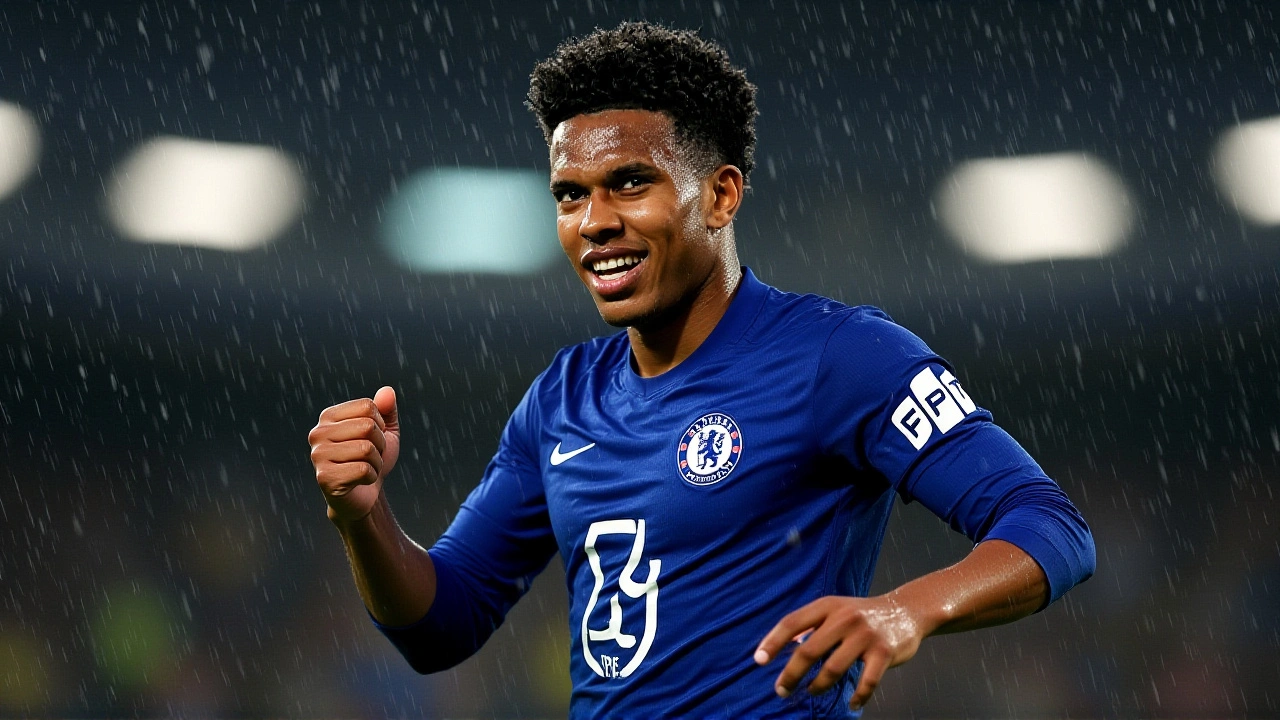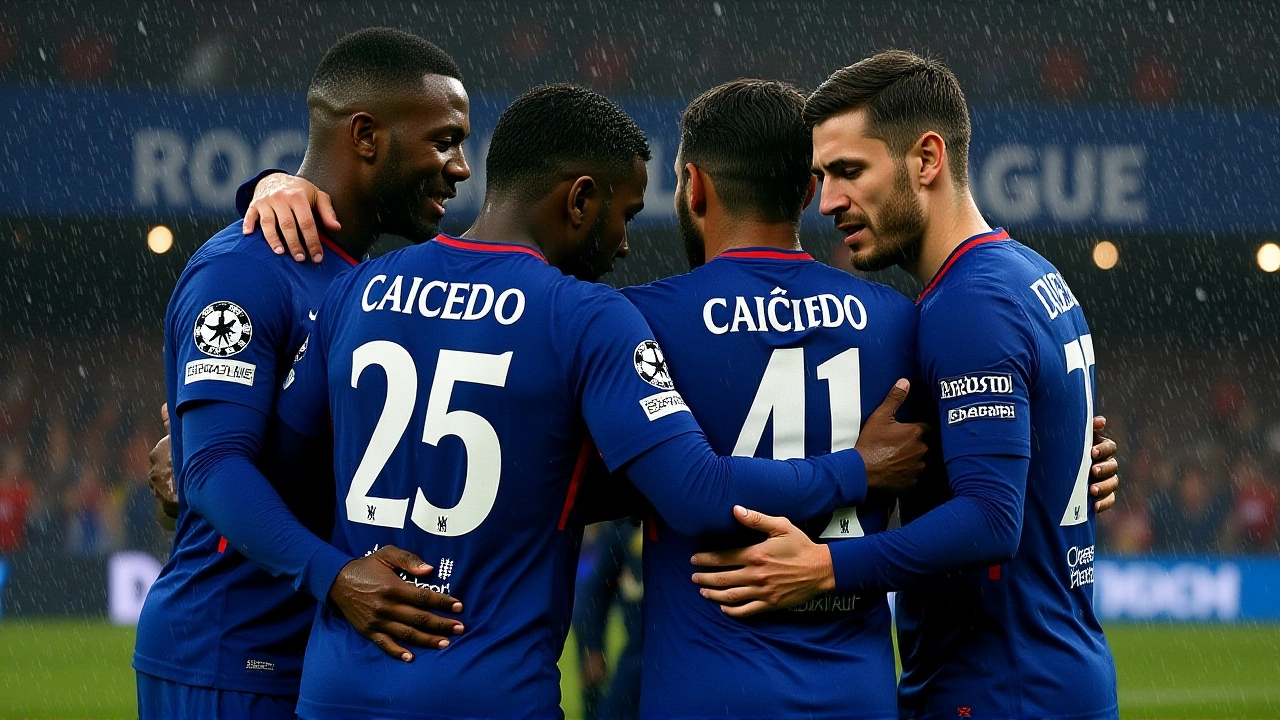On Wednesday, October 22, 2025, Chelsea FC turned Stamford Bridge into a historic stage, thrashing AFC Ajax 5-1 in the UEFA Champions League 2025/26 League Stage London — and in the process, shattered records thought unbreakable. Three teenagers, all under 20, found the net. One broke the club’s youngest UCL scorer record. Thirty-three minutes later, another broke it again. This wasn’t just a win. It was a statement — loud, youthful, and unmistakably Chelsea.
The Red Card That Changed Everything
The match began with Ajax, the Dutch giants, looking composed. But in the 15th minute, everything unraveled. Kenneth Taylor, the 22-year-old Ajax midfielder, lunged into a reckless challenge on Facundo Buonanotte, the 20-year-old Argentine winger. The referee didn’t hesitate. Red card. Ajax were down to 10. The atmosphere at Stamford Bridge shifted from anticipation to electricity. Chelsea smelled blood.
Just six minutes later, 19-year-old Spanish striker Marc Guiu pounced on a loose ball after a corner, slotting it past Ajax’s keeper. The goal was his first in European competition — and it broke Chelsea FC’s previous record for youngest UCL goalscorer, held since 2008. But no one had time to celebrate properly. The real shock was still coming.
Three Teenagers. One Night. History.
By the 28th minute, Moišés Caicedo, Chelsea’s £115 million Ecuadorian midfield anchor, doubled the lead with a deflected shot that looped over the keeper. Ajax pulled one back through veteran Dutch striker Wout Weghorst, converting a penalty after a handball in the box. But Chelsea responded with ruthless precision.
First, Enzo Fernández, the 24-year-old Argentine playmaker, buried a penalty in the 37th minute. Then, just before halftime, came the moment that left pundits speechless. Estêvão Willian, the 18-year-old Brazilian prodigy who joined from Palmeiras for £34 million in July, stepped up for Chelsea’s second penalty — and scored. At 18 years, 214 days, he became Chelsea’s new youngest UCL goalscorer. And here’s the twist: he did it just 33 minutes after Guiu had broken the record. No team in Champions League history had ever seen two different teenagers break the same club’s youngest goalscorer record in the same match — let alone in the same half.
Then, early in the second half, 19-year-old academy product Tyrique George came on as a substitute. His first touch? A clinical finish from six yards out. 5-1. Three teenagers. Three goals. One historic night. According to OptaJoe, Chelsea became the first side ever in Champions League history to feature three different teenagers scoring in a single match.
The Manager’s Words: ‘It Was Special’
Enzo Maresca, Chelsea’s Italian manager, stood at the post-match podium with a rare, wide smile. ‘It was special,’ he said. ‘Not because of the scoreline — though I’ll take it — but because of what those boys showed. They didn’t just play. They owned the moment. That’s the future right there.’
Maresca’s side didn’t just win with youth. They dominated. Chelsea maintained 54.5% possession, completed 90% of their passes, covered over 330 kilometers as a team, and recovered 130 balls. They had 24 tackles and only one red card — the one Ajax received. Their passing accuracy was the highest in any Champions League match this season. Even the stats were extraordinary.

What This Means for Chelsea’s Future
Before this match, Chelsea’s 2025/26 Champions League campaign was seen as a rebuilding year. They’d spent over £200 million on young talent in the summer — Guiu, Estêvão, George — and questions lingered about whether they could compete with Europe’s elite. Now? The narrative has flipped. This isn’t a project anymore. It’s a pipeline.
Estêvão’s record-breaking goal wasn’t just a moment. It was validation. A £34 million gamble that paid off in real time. George, an academy graduate, proved the youth system still works. Guiu, signed from Barcelona’s famed La Masia, showed he can deliver on the biggest stage. And Caicedo, the midfield engine, anchored it all with maturity beyond his years.
Compare this to Manchester United’s recent struggles with youth integration, or Liverpool’s reliance on veteran leadership. Chelsea, under Maresca, have built a team that doesn’t just develop talent — it unleashes it under pressure.
What’s Next?
Chelsea now sit top of their Champions League group with 7 points from 3 matches. Their next fixture is away at Bayer Leverkusen — a tough test, but one they’ll approach with growing confidence. The real test? Keeping this momentum through the winter. Can they maintain this level without injuries? Can the teenagers handle the media glare? Can Maresca keep them grounded?
One thing’s clear: UEFA’s official records will now include a new footnote — ‘First team with three teenage goalscorers in a single Champions League match.’ And the names? Guiu, Estêvão, George. Not stars yet. But they’re on the path.
Frequently Asked Questions
How did Chelsea manage to score three goals from teenagers in one match?
Chelsea’s youth development system, combined with strategic signings like Estêvão Willian and Marc Guiu, created a critical mass of talent. Manager Enzo Maresca gave them freedom to attack, and Ajax’s red card in the 15th minute opened the game. The combination of opportunity, confidence, and coaching allowed the teenagers to thrive under pressure — something rarely seen in elite European football.
Who is Estêvão Willian, and why is his record significant?
Estêvão Willian, an 18-year-old Brazilian forward signed from Palmeiras for £34 million in July 2025, became Chelsea’s youngest-ever UEFA Champions League goalscorer on October 22, 2025. He broke Marc Guiu’s record just 33 minutes after Guiu had set it — the first time in Champions League history two teenagers broke the same club’s youngest scorer record in one match. His poise on the penalty spot stunned even seasoned analysts.
What impact did Kenneth Taylor’s red card have on the match?
Taylor’s 15th-minute red card for a dangerous challenge on Facundo Buonanotte shifted the game’s balance completely. Ajax, already under pressure, lost midfield control and defensive shape. Chelsea capitalized with relentless intensity, scoring three goals in the next 25 minutes. Statistically, teams trailing by a goal after a red card in the Champions League win only 18% of the time — but Chelsea turned it into a rout.
How does this performance compare to past Chelsea youth breakthroughs?
While Chelsea once produced stars like John Terry and Frank Lampard through their academy, this is the first time three teenagers scored in a single Champions League match. The 2005-06 season saw Joe Cole and Michael Essien emerge, but none scored in Europe before age 19. This group — Guiu, Estêvão, George — did it in one night, signaling a new era of immediate impact rather than gradual development.
What do the stats say about Chelsea’s overall performance?
Chelsea averaged 90% passing accuracy, covered 330.58 kilometers as a team, and recovered 130 balls — all top-tier numbers. They’ve scored 9 goals in 3 group matches (2.25 per game), the best in the 2025/26 Champions League so far. Their 54.5% possession and 24 tackles won show they’re controlling games physically and technically — not just relying on youth flair.
Will this lead to more investment in young players at Chelsea?
Absolutely. With Estêvão, Guiu, and George delivering on the biggest stage, Chelsea’s recruitment strategy is validated. The club is likely to increase spending on U18–U21 talent, especially in South America and Spain. The success of this trio could make Chelsea the preferred destination for elite teenage prospects — not just for development, but for immediate Champions League exposure.

Neelam Dadhwal
November 11, 2025 AT 05:57This isn't football. It's a circus. Three kids scoring? Please. Ajax had a red card and still lost by four? That's not talent, that's incompetence on display. And now everyone's acting like Chelsea invented youth development? Wake up. This is a fluke fueled by poor defending and a referee with a death wish. Stop glorifying mediocrity.
vishal kumar
November 11, 2025 AT 23:19The convergence of opportunity and youthful exuberance in this match reveals a structural shift in elite football dynamics. The red card functioned as a catalyst, yet the execution by the teenagers reflects not mere luck but a systemic alignment of coaching philosophy, psychological readiness, and tactical discipline. History is not made by accident.
Oviyaa Ilango
November 12, 2025 AT 18:56Three teens scored. Big deal. The league is soft. Ajax were a shadow of themselves. Maresca got lucky. The system is broken if this is considered progress. Real football needs experience not children with cleats.
Aditi Dhekle
November 14, 2025 AT 17:45What's fascinating is the sociolinguistic shift in fan discourse around youth in football. We're witnessing a paradigm where 'potential' is no longer deferred-it's monetized, mythologized, and immediately weaponized in the media ecosystem. The boys didn't just score; they became data points in a global narrative machine. Fascinating. And slightly terrifying.
Aditya Tyagi
November 14, 2025 AT 23:12Why do people keep acting like these kids are special? I've seen 15 year olds score in backyard leagues. This is just a bunch of rich club kids getting lucky against a team that choked. And don't even get me started on that £34m kid-what a waste of money. Someone's pocket is getting fat and we're all supposed to clap?
pradipa Amanta
November 16, 2025 AT 08:54Everyone's acting like this is the second coming but let's be real-Ajax were playing with their third team. This match proves nothing except that Chelsea's payroll is bigger than your brain. The real story? The fact that people still think youth = future. Newsflash: most of them flame out by 22
chandra rizky
November 18, 2025 AT 03:44Wow. Just wow. 😊 This is why I love football. The energy, the passion, the way the game keeps evolving. These kids are the heartbeat of the sport. Chelsea's future looks bright and honestly? It's beautiful to see. Keep going, boys. 🙌
Rohit Roshan
November 18, 2025 AT 08:21This is the kind of moment that makes you believe in football again. Three teenagers, one night, rewriting history. It's not just about goals-it's about courage. They didn't wait for permission. They took the stage. And the world watched. 🌟
arun surya teja
November 19, 2025 AT 12:32The emergence of youth in elite competition signals a maturation of institutional planning rather than mere serendipity. Chelsea's investment in long-term development infrastructure has yielded measurable outcomes. This is not an anomaly but an evolution. The club's model deserves scholarly attention.
Jyotijeenu Jamdagni
November 19, 2025 AT 17:48Man. I swear I just saw a 18-year-old Brazilian kid take a penalty like he was ordering coffee. And then a 19-year-old academy kid comes off the bench and scores like he'd been doing it his whole life. This ain't just football anymore-it's magic with cleats. I'm not even mad about the £34m. Worth every penny. 🤯
navin srivastava
November 20, 2025 AT 13:07india has better youth academies than this. Chelsea got lucky. Ajax let them win. And now the media is acting like this is the second coming of pele. Wake up. This is not greatness. This is a fluke. And someone needs to check the ref's eyes
Aravind Anna
November 20, 2025 AT 15:13They didn't just score they owned the pitch. This isn't a fluke. This is a revolution. Every kid in India watching this right now just saw their future. This is what football is supposed to be. Raw. Real. Unstoppable. Maresca didn't coach them-he unleashed them. And now the whole world knows it
Rajendra Mahajan
November 20, 2025 AT 23:59One cannot ignore the anthropological implications of this match. The stadium became a temple of generational transition. The teenagers were not merely athletes but symbols of a new episteme in sports culture. Their goals were not just entries in a ledger but rituals of legitimacy. The red card was the sacrificial offering. The crowd, the congregation.
ANIL KUMAR THOTA
November 22, 2025 AT 20:11Three teenagers. One night. History. No more words needed. Just watch it again. And again.